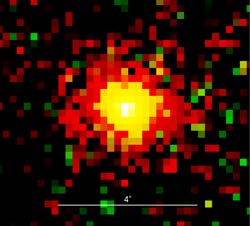Giant Galaxy Hosts the Most Distant Supermassive Black Hole

False-color image of the QSO (CFHQSJ2329-0301), the most distant black hole currently known. In addition to the bright central black hole (white), the image shows the surrounding host galaxy (red). The white bar indicates an angle on the sky of 4 arcseconds or 1/900th of a degree. Image: Tomotsugu GOTO, University of Hawaii<br>
The galaxy, so distant that it is seen as it was 12.8 billion years ago, is as large as the Milky Way galaxy and harbours a supermassive black hole that contains at least a billion times as much matter as our Sun. The scientists set out their results in a paper in the journal Monthly Notices of the Royal Astronomical Society later this month.
Dr. Goto stated, “It is surprising that such a giant galaxy existed when the Universe was only one-sixteenth of its present age, and that it hosted a black hole one billion times more massive than the Sun. The galaxy and black hole must have formed very rapidly in the early Universe.”
Knowledge of the host galaxies of supermassive black holes is important in order to understand the long-standing mystery of how galaxies and black holes have evolved together. Until now, studying host galaxies in the distant Universe has been extremely difficult because the blinding bright light from the vicinity of the black hole makes it more difficult to see the already faint light from the host galaxy.
Unlike smaller black holes, which form when a large star dies, the origin of the supermassive black holes remains an unsolved problem. A currently favoured model requires several intermediate black holes to merge. The host galaxy discovered in this work provides a reservoir of such intermediate black holes. After forming, supermassive black holes often continue to grow because their gravity draws in matter from surrounding objects. The energy released in this process accounts for the bright light emitted from the region around the black holes.
To see the supermassive black hole, the team of scientists used new red-sensitive Charge Coupled Devices (CCDs) installed in the Suprime-Cam camera on the Subaru telescope on Mauna Kea. Prof. Satoshi Miyazaki of the National Astronomical Observatory of Japan (NAOJ) is a lead investigator for the creation of the new CCDs and a collaborator on this project. He said, “The improved sensitivity of the new CCDs has brought an exciting discovery as its very first result.”
A careful analysis of the data revealed that 40 percent of the near-infrared light observed (at the wavelength of 9100 Angstroms) is from the host galaxy itself and 60 percent is from the surrounding clouds of material (nebulae) illuminated by the black hole.
Yousuke Utsumi (Graduate University for Advanced Studies /NAOJ), a member of the project team, said, “We have witnessed a supermassive black hole and its host galaxy forming together. This discovery has opened a new window for investigating galaxy-black hole co-evolution at the dawn of the Universe.”
Dr. Goto is a fellow of the Japan Society for the Promotion of Science (JSPS). He received his PhD from the University of Tokyo in 2003 and has also worked at Carnegie Mellon and Johns Hopkins universities, and at the Institute of Space and Astronautical Science, a part of JAXA, the Japanese equivalent of NASA. He came to UH Institute for Astronomy in 2008 to work with Dr. David Sanders on quasi-stellar objects (QSOs) and luminous infrared galaxies.
Other members of the research team are Dr. Hisanori Furusawa (NAOJ) and Dr. Yutaka Komiyama (NAOJ).
Full bibliographic information
“A QSO Host Galaxy and its Lyman alpha emission at z=6.43”, Goto T., Utsumi Y., Furusawa H., Miyazaki S. and Komiyama Y., Monthly Notices of the Royal Astronomical Society, in press.
Media Contact
More Information:
http://www.ras.org.ukAll latest news from the category: Physics and Astronomy
This area deals with the fundamental laws and building blocks of nature and how they interact, the properties and the behavior of matter, and research into space and time and their structures.
innovations-report provides in-depth reports and articles on subjects such as astrophysics, laser technologies, nuclear, quantum, particle and solid-state physics, nanotechnologies, planetary research and findings (Mars, Venus) and developments related to the Hubble Telescope.
Newest articles

Silicon Carbide Innovation Alliance to drive industrial-scale semiconductor work
Known for its ability to withstand extreme environments and high voltages, silicon carbide (SiC) is a semiconducting material made up of silicon and carbon atoms arranged into crystals that is…

New SPECT/CT technique shows impressive biomarker identification
…offers increased access for prostate cancer patients. A novel SPECT/CT acquisition method can accurately detect radiopharmaceutical biodistribution in a convenient manner for prostate cancer patients, opening the door for more…

How 3D printers can give robots a soft touch
Soft skin coverings and touch sensors have emerged as a promising feature for robots that are both safer and more intuitive for human interaction, but they are expensive and difficult…





















